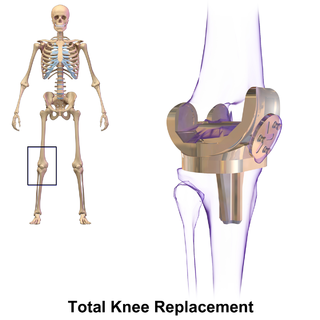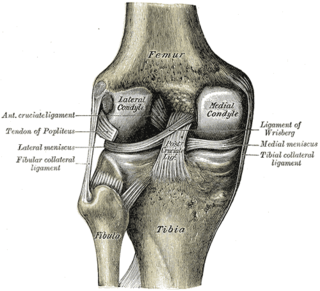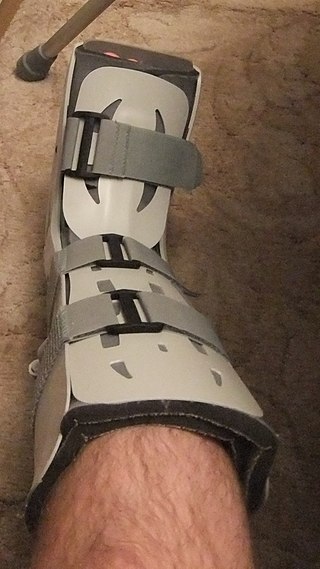
Orthopedic surgery or orthopedics is the branch of surgery concerned with conditions involving the musculoskeletal system. Orthopedic surgeons use both surgical and nonsurgical means to treat musculoskeletal trauma, spine diseases, sports injuries, degenerative diseases, infections, tumors, and congenital disorders.

An orthopedic cast, or simply cast, is a shell, frequently made from plaster or fiberglass, that encases a limb to stabilize and hold anatomical structures—most often a broken bone, in place until healing is confirmed. It is similar in function to a splint.

Peroneal nerve paralysis is a paralysis on common fibular nerve that affects patient’s ability to lift the foot at the ankle. The condition was named after Friedrich Albert von Zenker. Peroneal nerve paralysis usually leads to neuromuscular disorder, peroneal nerve injury, or foot drop which can be symptoms of more serious disorders such as nerve compression. The origin of peroneal nerve palsy has been reported to be associated with musculoskeletal injury or isolated nerve traction and compression. Also it has been reported to be mass lesions and metabolic syndromes. Peroneal nerve is most commonly interrupted at the knee and possibly at the joint of hip and ankle. Most studies reported that about 30% of peroneal nerve palsy is followed from knee dislocations.
A soft tissue injury is the damage of muscles, ligaments and tendons throughout the body. Common soft tissue injuries usually occur from a sprain, strain, a one-off blow resulting in a contusion or overuse of a particular part of the body. Soft tissue injuries can result in pain, swelling, bruising and loss of function.

A crutch is a mobility aid that transfers weight from the legs to the upper body. It is often used by people who cannot use their legs to support their weight, for reasons ranging from short-term injuries to lifelong disabilities.

Achilles tendon rupture is when the Achilles tendon, at the back of the ankle, breaks. Symptoms include the sudden onset of sharp pain in the heel. A snapping sound may be heard as the tendon breaks and walking becomes difficult.

Anterior cruciate ligament reconstruction is a surgical tissue graft replacement of the anterior cruciate ligament, located in the knee, to restore its function after an injury. The torn ligament can either be removed from the knee, or preserved before reconstruction through an arthroscopic procedure. ACL repair is also a surgical option. This involves repairing the ACL by re-attaching it, instead of performing a reconstruction. Theoretical advantages of repair include faster recovery and a lack of donor site morbidity, but randomised controlled trials and long-term data regarding re-rupture rates using contemporary surgical techniques are lacking.

Knee replacement, also known as knee arthroplasty, is a surgical procedure to replace the weight-bearing surfaces of the knee joint to relieve pain and disability, most commonly offered when joint pain is not diminished by conservative sources. It may also be performed for other knee diseases, such as rheumatoid arthritis. In patients with severe deformity from advanced rheumatoid arthritis, trauma, or long-standing osteoarthritis, the surgery may be more complicated and carry higher risk. Osteoporosis does not typically cause knee pain, deformity, or inflammation, and is not a reason to perform knee replacement.

A meniscus is a crescent-shaped fibrocartilaginous anatomical structure that, in contrast to an articular disc, only partly divides a joint cavity. In humans, they are present in the knee, wrist, acromioclavicular, sternoclavicular, and temporomandibular joints; in other animals they may be present in other joints.

A mobility scooter is an electric personal transporter used as mobility aid for people with physical impairment, mostly auxiliary to a powered wheelchair but configured like a motorscooter. When motorized they function micromobility devices and are commonly referred to as a powered vehicle/scooter, or electric scooter. Non-motorized mobility scooters are less common, but are intended for the estimated 60% of wheelchair users who have at least some use of their legs. Whilst leg issues are commonly assumed to be the reason for using scooters, the vehicles are used by those with a wide range of conditions from spinal injuries to neurological disorders.

Foot drop is a gait abnormality in which the dropping of the forefoot happens due to weakness, irritation or damage to the deep fibular nerve, including the sciatic nerve, or paralysis of the muscles in the anterior portion of the lower leg. It is usually a symptom of a greater problem, not a disease in itself. Foot drop is characterized by inability or impaired ability to raise the toes or raise the foot from the ankle (dorsiflexion). Foot drop may be temporary or permanent, depending on the extent of muscle weakness or paralysis and it can occur in one or both feet. In walking, the raised leg is slightly bent at the knee to prevent the foot from dragging along the ground.
A selective dorsal rhizotomy (SDR), also known as a rhizotomy, dorsal rhizotomy, or a selective posterior rhizotomy, is a neurosurgical procedure that selectively cut problematic nerve roots of the spinal cord. This procedure has been well-established in the literature as a surgical intervention and is used to relieve negative symptoms of neuromuscular conditions such as spastic diplegia and other forms of spastic cerebral palsy. The specific sensory nerves inducing spasticity are identified using electromyographic (EMG) stimulation and graded on a scale of 1 (mild) to 4. Abnormal nerve responses are isolated and cut, thereby reducing symptoms of spasticity.

Microfracture surgery is an articular cartilage repair surgical technique that works by creating tiny fractures in the underlying bone. This causes new cartilage to develop from a so-called super-clot.
Gait training or gait rehabilitation is the act of learning how to walk, either as a child, or, more frequently, after sustaining an injury or disability. Normal human gait is a complex process, which happens due to co-ordinated movements of the whole of the body, requiring the whole of Central Nervous System - the brain and spinal cord, to function properly. Any disease process affecting the brain, spinal cord, peripheral nerves emerging from them supplying the muscles, or the muscles itself can cause deviations of gait. The process of relearning how to walk is generally facilitated by Physiatrists or Rehabilitation medicine (PM&R) consultants, physical therapists or physiotherapists, along with occupational therapists and other allied specialists. The most common cause for gait impairment is due to an injury of one or both legs. Gait training is not simply re-educating a patient on how to walk, but also includes an initial assessment of their gait cycle - Gait analysis, creation of a plan to address the problem, as well as teaching the patient on how to walk on different surfaces. Assistive devices and splints (orthosis) are often used in gait training, especially with those who have had surgery or an injury on their legs, but also with those who have balance or strength impairments as well.

A tear of a meniscus is a rupturing of one or more of the fibrocartilage strips in the knee called menisci. When doctors and patients refer to "torn cartilage" in the knee, they actually may be referring to an injury to a meniscus at the top of one of the tibiae. Menisci can be torn during innocuous activities such as walking or squatting. They can also be torn by traumatic force encountered in sports or other forms of physical exertion. The traumatic action is most often a twisting movement at the knee while the leg is bent. In older adults, the meniscus can be damaged following prolonged 'wear and tear'. Especially acute injuries can lead to displaced tears which can cause mechanical symptoms such as clicking, catching, or locking during motion of the joint. The joint will be in pain when in use, but when there is no load, the pain goes away.

A mobility aid is a device designed to assist walking or otherwise improve the mobility of people with a mobility impairment.

A wheelchair is a mobilized form of chair using 2 or more wheels, a footrest and armrest usually cushioned. It is used when walking is difficult or impossible to do due to illnesses, injury, disabilities, or age related health conditions.

Brachymetatarsia is a rare malformation that causes one or more toes to be abnormally short. The condition is characterized by a metatarsal arch shortness of more than 5 mm. The condition is more common in females, and the incidence reported in the literature ranges from 0.02% to 0.05%. Brachymetatarsia appears to be the result of epiphyseal plate retardation or premature closure. The etiology may be congenital and idiopathic, posttraumatic, postinfection, iatrogenic, or secondary to a systemic disease such as cancer, sickle cell disease, pseudohyperparathyroidism, Turner's syndrome, Down's syndrome, Apert syndrome, athyroidism, or osteodystrophy.

A femoral fracture is a bone fracture that involves the femur. They are typically sustained in high-impact trauma, such as car crashes, due to the large amount of force needed to break the bone. Fractures of the diaphysis, or middle of the femur, are managed differently from those at the head, neck, and trochanter; those are conventionally called hip fractures. Thus, mentions of femoral fracture in medicine usually refer implicitly to femoral fractures at the shaft or distally.

A controlled ankle motion walking boot, also referred to as a controlled ankle movement walking boot, below knee walking boot, CAM boot, CAM walker, or moon boot, is an orthopedic device prescribed for the treatment and stabilization of severe sprains, fractures, and tendon or ligament tears in the ankle or foot. In situations where ankle motion but not weight is to be limited, it may be used in place of a cast.

















